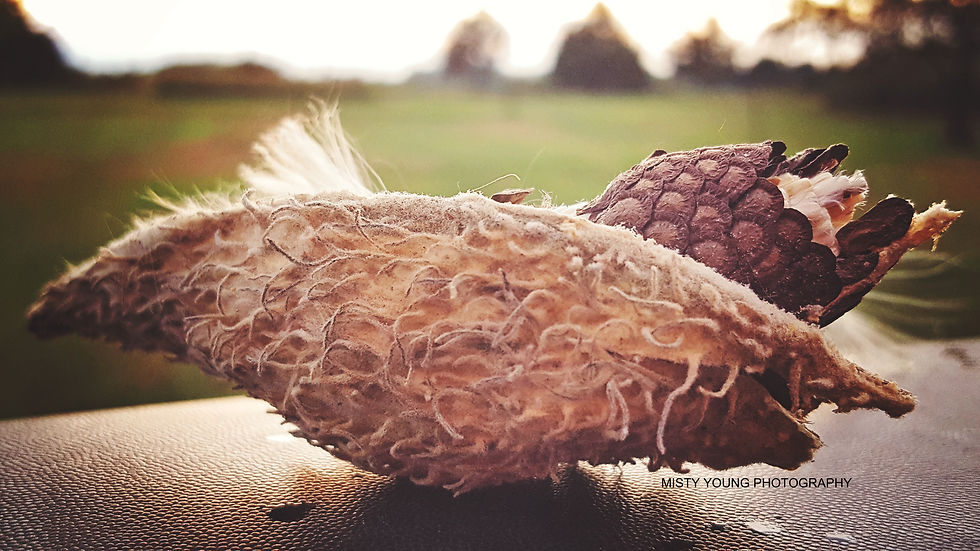Pods, Pods, Everywhere!!!
- Misty
- Sep 22, 2019
- 4 min read

Milkweed! One of the best weeds, in my opinion. Not only do the flowers of common milkweed, smell absolutely incredible when they bloom, milkweed is THE food source of the Monarch caterpillar. It is the ONLY thing that they eat. Without milkweed, we cannot and will not, have monarchs. So it goes without saying, that it is imperative to have it. Right now, in the Midwest, it is harvest time for common milkweed seeds.


Today we will learn about harvesting milkweed seeds, so we can have more milkweed and more monarchs, of course! Here in the Midwest, we are lucky enough to have common milkweed (Asclepias Syriaca) the leaves of common milkweed are gigantic! (Which is helpful for feeding lots of very hungry caterpillars!) Around me, and in very rural areas, milkweed grows along roadsides, in ditches, and along the sides of the highways. It is easily recognizable because it is so tall (sometimes the plant can be over 6ft tall) and the leaves are so large (often times the leaves are larger than your outstretched hand)
If you are lucky enough to find a patch of mature milkweed that has seed pods ready for harvest, we want to make sure you know how to get them, so we can all plant even more milkweed for our monarchs. (seed pods do not generally appear on common milkweed until year 3)

The pods are fairly large, so they too, are very easy to spot, and you can't really miss them. What I do is, I just take an old grocery bag or trash bag and pick as many pods as I can.

When looking for seed pods that are ready, you want to make sure the pods are no longer bright green. Once they've started to turn dull green or brown, the the seeds are likely ready. You can test this by pressing on the seam at the bottom of the pod. If it does not open easily, it is probably not ready for harvest. If it does pop open easily, peek inside before you remove the pod from the plant, to make sure that the seeds are dark brown. If the seeds are light brown or white they are not ready yet, and you will have to wait until another day to come back and harvest pods.
I have seen some instances that, people will put rubber bands around the pods so they do not bust open, or organza bags so the seeds cannot blow away. There is no one right way, always see what will work best for you, and do it! Either of these methods may work for you if you cannot check the pods regularly, some do this so the pods will be ready for picking when they are able to make it back for harvesting them.
Once I've gotten all the pods that I want. (That can be found) I take them home for separating.
Pic 1 Pic 2 Pic 3
Pic 1 Seam on the underside of pod
Pic 2 Seeds are visibly brown
Pic 3 Brown seeds ready for harvest
The first thing you'll notice upon opening your pods is all the white fluff. This stuff can be messy! But it doesn't have to be. Sometimes the seeds come out very easily without making a mess and the fluff stays in place. Other times not so much. But don't worry there is a trick. You can take an old paper bag, and put a few pennies in with the seeds and fluff. fold over the top of the bag so it is closed, then shake it vigorously. When you open the bag the fluff will be separated from the seeds.

Once your seeds are separate. you should let them dry for about 4 weeks before storing them in a dry location (you always want to avoid moisture and ultimately, mold when storing seeds, if there is mold your seeds will likely not germinate) You can then plant your seeds in the spring or start them in your green house (tip - common milkweed seeds must be cold stratified in order to germinate)

Another option, after the seeds have dried out, is to plant them outdoors and let nature do the work for you. This is my preferred method. I believe nature knows best, and because I always seem to have a ton going on, I'm always all for the easy route! Because common milkweed seeds require cold stratification, in the Midwest, you can plant the milkweed seeds around the start of the winter solstice (or just before Christmas)

For me, I'm not too picky, so I just grab a handful and scatter them in a general area. Be aware, with this method, weather and/or foraging animals, may make your seeds drift a bit. If you would like to keep them more contained to a specific location, you may want to prepare the ground with either a little mulch or put a little soil over the top no more than 1/2 inch. When spring comes back around, you should have several new milkweed plants and even more food for visiting monarchs to lay their eggs on!

Helpful Hint: Always make sure you wash your hands thoroughly after handling any part of the milkweed plant, the sap from milkweed is a very powerful eye irritant. I had mentioned in one of my previous blogs, like a surgeon, scrub in before handling the caterpillars, scrub out after handling the milkweed. You may not need to be as thorough as a surgeon, but it's a nice little mantra that keeps it at the forefront of my mind so I don't forget. Better safe than sorry.

Happy Harvesting!!!!!
How many pods did you find?
Be sure to Like, Subscribe and Share to stay up to date on all of our posts!
Follow us on Facebook @mistysmonarchsandmore and Instagram #mistysmonarchsandmore












Comments